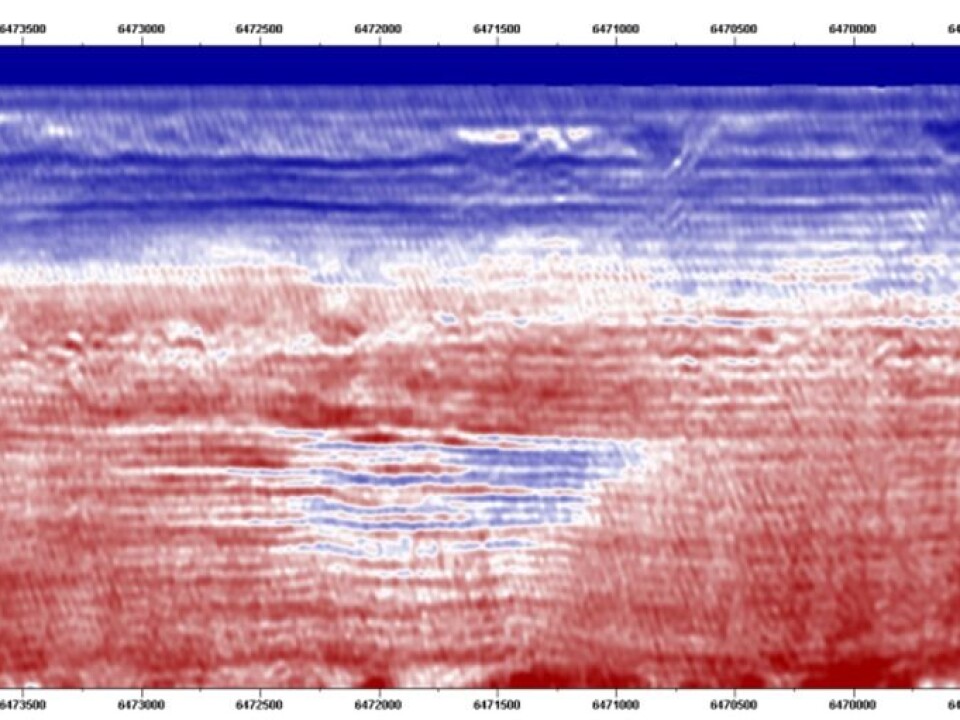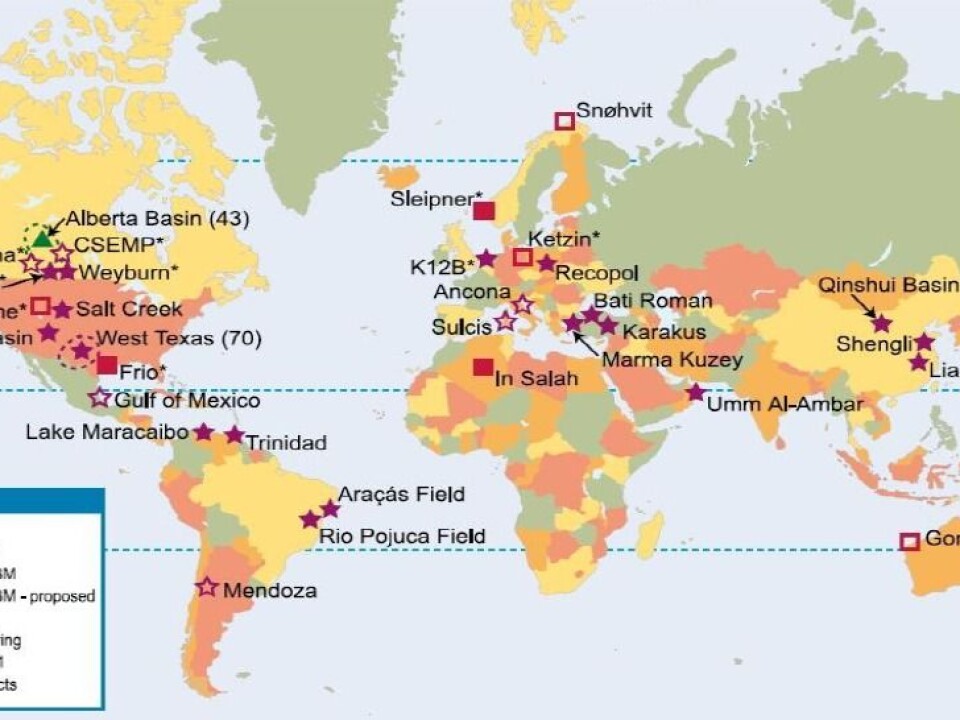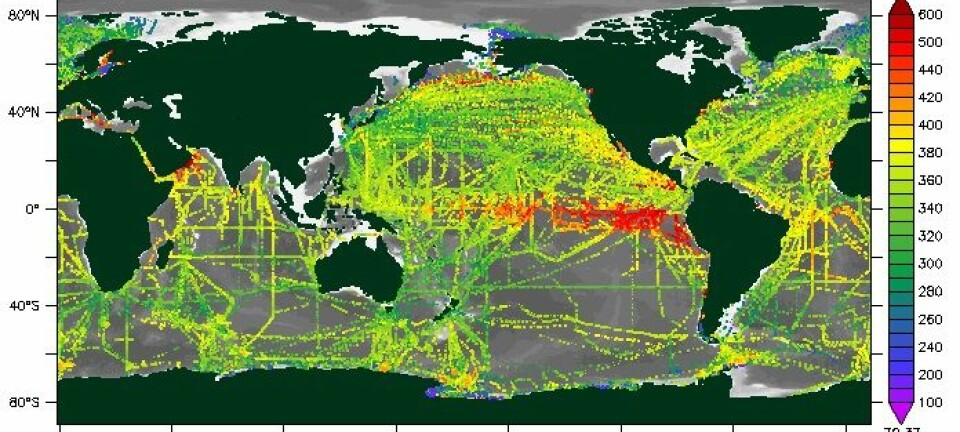An article from Norwegian SciTech News at SINTEF

How are we going to store the problem gas CO2?
CO2 is the great scapegoat of our age. Is there a way to get rid of it by burying it in the ground or beneath the sea bed?
Denne artikkelen er over ti år gammel og kan inneholde utdatert informasjon.
"If we want to inject gas underground or beneath the sea bed, we will have to monitor what happens to it. We have to be entirely sure that it stays where it's supposed to".
So says SINTEF researcher Peder Eliasson. He and his colleagues in their office building opposite Lerkendal Stadium, are analysing seismic and electromagnetic data taken from the CO2 sequestration reservoir below the sea bed at the Sleipner field in the North Sea.
"But how can we be sure that the gas will stay where it's supposed to"?
"By interpreting geophysical data. During seismic surveys, we send down acoustic signals that are then reflected back, enabling us to determine distances and dimensions on the basis of the echoes. We then use these to determine the location and extent of the gas. What we do is compare the seismic data before and after injection", says Eliasson.

He says that there are many centres around the world studying data from various CO2 storage reservoirs, because it is important to learn how to make the best possible use of this information. He maintains that certainty is the key factor in CO2 sequestration. The risk of leaks is very small, but this has to documented very accurately. Measurement equipment must be robust and not too expensive, and the data must be accurate. It must also be possible to customise the analyses.
Climate change challenge
CO2 has become the symbol of human consumption and industrial production. The gas that pours out of cement factory chimneys and belches out of exhaust pipes and combustion plants is the reason behind the biggest environmental challenge of our age.
This is why researchers all over the world are working to find sound ways of capturing CO2 and pumping it beneath the surface of the earth, where it can remain safely stored away for thousands of years.
Numerous industrial projects have demonstrated that this is possible. However, there is a great deal of work still to be done before an optimal CO2 storage solution is in place. The question is also whether we can store volumes large enough to help prevent global temperatures increasing by more than two degrees.
Small scale testing

At the Sleipner gas field, Statoil operates the oldest CO2 sequestration project in the world, with around 15 million tonnes of CO2 already stored underground – more than the amount generated by all the cars in Norway in a two-year period. Almost one million tonnes are pumped down beneath the sea bed every year.
In 2008, CO2 storage operations started from the processing facility on Melkøya in northern Norway. From here, gas is transported in a pipeline out to the Snøhvit field, where it is injected into a dedicated formation beneath the field's gas-bearing reservoirs.
SINTEF has been working for many years with the Norwegian University of Science and Technology (NTNU) and the UK-based company BGS on the development of methods to make monitoring more accurate and reliable. Over the last few years, it has also been working with GFZ in Germany, where researchers have established a land-based pilot for the injection of CO2 to a depth of 600 metres underground.
Since 2014, Norwegian researchers have been in contact with the University of Illinois about the Decatur project in the USA, and with CaMI at its Field Research Station in Canada. But in general, testing has been on a small scale.
"SINTEF Petroleum Research is performing a range of experiments as a means of analysing CO2 sequestration issues”, says Eliasson. “We are researching into everything from how the gas behaves in the reservoir and how great the risk is for leaks through the caprock or wells, to calculations of storage capacity and the development of monitoring methods. The latter is my speciality. Elsewhere at SINTEF, research is focusing on the major BIGCCS research centre", he says.
Monitoring could be better
A CO2 sequestration reservoir beneath the sea bed must be at least 800 metres below the sea surface if it is to exert a pressure that gives the gas a density similar to that of water. This makes storage more efficient. Seismic images from the Utsira Formation at the Sleipner field indicate that the reservoir is stable and is not leaking gas up to the sea bed.
Eliasson digs out a chart. It shows the gas as a thin, blue layer surrounded by a red area. Over the last few years, the gas at Sleipner has migrated to the top of the sandstone layer, and is lying in a thin band beneath the impermeable shale that forms the roof of the reservoir.
"The field is blue. Why is that"?
"Variations in seismic velocity are represented by different colours. In areas where CO2 is present, sound waves travel more slowly than in the surrounding rocks. This is expressed by the blue colour in the figure.
However, it's not enough for us merely to obtain an image of the gas that is down there. According to Eliasson, the images don't tell us anything about what degree of certainty we have, or whether there is a risk of small leaks. He believes it is essential for us to find out how much is there, and to put a figure on our margin of uncertainty. Is it ten million tonnes plus/minus 50 per cent, or is it plus/minus 5 per cent?
We need to achieve the highest possible degree of certainty, and that is why researchers are studying several different types of data. "We're looking at multiple data sets, and combining seismic data with electromagnetic and gravimetric data in order to achieve the best possible result", says Eliasson.
A question of money
One obstacle in the way of large-scale CO2 sequestration is the financial aspect. Modifying a coal or gas power station to capture its CO2 involves a considerable increase in costs. On top of this, it would be necessary to build the infrastructure to transport the gas to its final storage location.
The costs of capture and storage are significant.
"Even though the licence-holders at Sleipner Vest would have to pay a huge amount per day to the Norwegian government if the gas did escape into the atmosphere, as long as international CO2 emissions don't cost any more than that, it isn't profitable for the industry to invest more in capture and storage", says Eliasson. "One scenario is to create a global system of duties related to CO2 emissions, and for governments to play their part and develop the necessary infrastructure. That would open up a range of new opportunities", he says.
Storage is essential
Most political signals suggest that fossil fuels will dominate global energy supply until the middle of this century. The IPCC also says that CO2 sequestration is essential if we are to achieve emissions reductions that really make a difference.
In Brussels, carbon capture is attracting new attention, and many public and private sector players are realising that there is an urgent need to get the technology in place. The EU Commission is now trying to get better subsidy schemes in place from 2020. The most emission-intensive areas of northern Europe have no real alternatives to CO2 capture and storage. This means that there will be a huge demand for a sequestration infrastructure.
It has been pointed out that this type of storage could be a practical tool that will allow humans to carry on burning fossil fuels.
Sirin Engen in the environmental NGO, Bellona, admits that this is a technology that would allow the oil and gas industry to play a role in the transition to a low-emissions society. "But this is not a rescue mission, and it does not absolve the industry of its responsibility to cut CO2 emissions", she states on their website.
Peder Eliasson at SINTEF does not want to make predictions or express an opinion on the moral aspects here. "Our task is to be objective and to contribute with new knowledge and technologies", he says.
However, like many others, he believes that CO2 capture and storage could be one of the key factors driving the so-called 'green shift', where the petroleum industry will also play a part.
-------------------------------------
Read the Norwegian version of this article at forskning.no



































